|
The 7th September, 1953 was the first day
at school for the new headmaster, Mr. Reginald
Walter Mayland. He had taught in the Darlaston area
for many years, first at Kings Hill School and later
as headmaster at Addenbrooke Street Primary School.
Mr. Mayland soon became a well-liked and respected
headmaster, and a great asset to Pinfold Street
School.
|
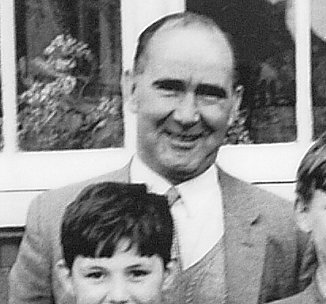
Mr. Mayland.
Courtesy of Sue Harper,
Gill Broomhall and Maureen Page. |
|
Although the school had been extremely fortunate to
acquire the services of Mr. Mayland, his appointment
came at a cost. Addenbrooke Street Primary School was
now without a headmaster, and as a result, Mr. Hudson,
one of Pinfold Street School’s most experienced members
of staff, was transferred to Addenbrooke Street as Mr.
Mayland’s replacement. He left the school on Friday 16th
October and returned the following Tuesday with his wife
for a presentation.
Unfortunately this was not such a good day for Miss
Haigh. She slipped and fell in the corridor, straining a
ligament in her arm and breaking her dentures in the
process. It wasn’t however, all bad news for her that
month. |
| At the first school manager’s meeting of the term,
the decision was taken to create two posts of special
responsibility, each with a small rise in salary. One
was for Miss Haigh and the other for Mr. Scarth. Yet
another familiar school figure appeared at that time.
The school acquired its first Road Safety Patrol Man on
November 20th, 1953, his name was Mr. Wooton.
Also during the term the school’s first set of
curtains for the stage were fitted and the P.T. shed,
for storing the P.T. equipment, was completed.
|
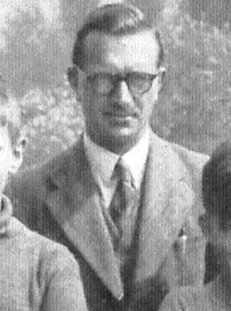
Mr. Hudson. Courtesy of Sue
Harper,
Gill Broomhall and Maureen Page. |
| Christmas and the end of the year are always a time
of celebration and this was not overlooked at the
school. For many years Mr. Mayland and his staff
organised a series of school plays, each performed by a
different class, in front of the whole school. On some
occasions parents were invited to come and view the
proceedings, which could occur on two or three days in a
row, or as a single evening event, sometimes with carol
singing. On the 14th December, 1953 three
plays were performed. Class 8’s play was called “Mimes”,
class 4’s was called “Sneezing Powder”, and class 1’s
play was entitled “Cabbages and Kings”. Two days later
plays were performed by classes 3, 2, and 7. A large
Christmas tree would always be a feature in the hall in
good time for the Christmas festivities. In the 1950s
the Christmas party usually took place on the last but
one day of term. There would be a plentiful supply of
jellies, cakes, and fruit, and several mothers would be
on hand to help. The Chairman of the school managers,
Councillor Mrs. Wilkinson sometimes came along to
join in the merriment, and a good time would be had by
all.
The last day of term included a carol service and the
distribution of presents to the children. The infants
usually received a toy or sweets and the juniors
received ice cream.
|
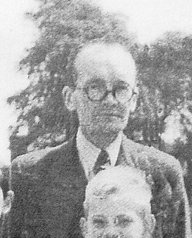
Mr. Scarth in the early 1950s.
Courtesy of Sue Harper,
Gill
Broomhall and Maureen Page. |
During Mr. Mayland’s time at the school the
children’s parents were actively encouraged to attend a
number of annual events. There were school open
afternoons and open evenings, school sports afternoons
and the school trip. During the open afternoons and
evenings, held at the end of the summer term, parents
could view examples of the children’s work.
There would be displays of arts and crafts,
needlework, poetry recitals, the school choir would
perform, and Councillor Mrs. Wilkinson was usually on
hand to present prizes to the most successful children.
As many as 200 parents came along.
|
| As the school was still without a playing field in
the 1950s, the annual sports would usually be held at
Guest, Keen and Nettlefolds sports ground in Hall
Street. The four houses, Red, Yellow, Green and Blue
would compete in the event and prizes were presented to
the winners. In 1954 Mrs. Thacker came to present the
prizes. Yellow House were the champions, with Gillian
Butler, champion girl, and Kenneth Dangerfield, champion
boy. In 1955 it was the turn of Red House to win the
cups and medals. The champion girl and boy were Valerie
Berry and Raymond Cornforth, and the prizes were
presented by Councillor H. Partridge. In 1957 Blue House
won the day in glorious weather. The two champions were
Irene Fieldhouse and Alan Green. On this occasion the
prizes were presented by Councillor Mrs. Wilkinson. The
following year it was the turn of Yellow House again,
the champion boy and girl being Brenda Morgan and
Terence Stanley. Mrs. Mayland was on hand to present the
prizes. Children from the school also took part in
Darlaston Primary Schools Sports, achieving second place
to Bentley South Primary School in 1957. |
| During the latter half of the 1950s more emphasis
was placed on swimming, and children would regularly
attend lessons at Darlaston Baths. In those days the
class would walk from the school to the baths
accompanied by a teacher. Each child would carry their
swimming costume rolled inside a towel. The primitive
changing rooms were along the side of the pool.
The children could pass a series of tests, starting
at test 1 and going through to test 6. The lessons
proved to be a great success with large numbers of
children passing more than 1 test. Mr. Mayland summed it
up in 1957 as follows “A remarkable achievement as most
of the children who attended the baths have learned to
swim”. |
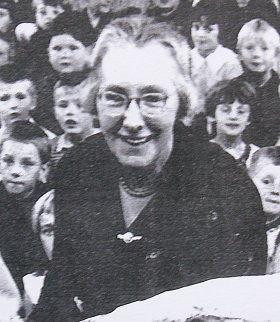
| Miss Haigh.
Courtesy of Sue Harper,
Gill Broomhall and Maureen Page. |
|
| The number of children who passed the swimming tests
are as follows: |
| |
Number of
Passes |
| |
1954 |
1957 |
1958 |
1959 |
| Test 1 |
35 |
46 |
32 |
41 |
| Test 2 |
22 |
46 |
17 |
21 |
| Test 3 |
4 |
4 |
8 |
10 |
| Test 4 |
2 |
2 |
1 |
4 |
| Test 5 |
1 |
2 |
1 |
3 |
| Test 6 |
1 |
1 |
0 |
1 |
| The
results for 1955 and 1956 were not recorded in the
school log book. |
| During the 1950s physical education began to be
taken more seriously, and in May 1954 climbing ropes and
wall bars were installed in the hall. Before the end of
the decade the area P.E. supervisor would occasionally
call to inspect classes and ensure that they were taken
correctly.
Another important activity, greatly enjoyed by many
children was cycling. In the late 1950s the roads were
comparatively empty by modern standards, but the amount
of traffic was greatly increasing and so road awareness
became more important than ever. As a result, cycling
courses, leading to a Cycling Proficiency Test began to
take place in the playground on Saturday afternoons. The
first short course, run by Mr. Whitting, a Road Safety
Officer, began on 25th May, 1957. The Cycling
Proficiency Tests were carried out 4 weeks later on 22nd
June.
|
|

A class in the mid 1950s.
Names Left to Right:
Back Row: extreme left Iris Burke,
last but one on the right Terence Stanley.
2nd Row:
3rd from the left Brenda Morgan, 6th from the left
Michael Vernon, Bev Parker, John Labon.
Front Row:
Alan Griffiths, Joseph
Bott, Keith Rhodes, Graham Skidmore, Reginald Kemp, John
Rickhuss, Malcolm Green, the Firm twins.
Conductor: Barry Foulkes |
| There were other out-of –school activities. On the
afternoon of the 1st April, 1954 classes 1 to
4 and their teachers went to the Olympia Cinema in
Darlaston to see the film “The Ascent of Everest”. At
the time the first ascent of the mountain greatly caught
people’s imagination and boosted national pride. On the
12th June, 1958 the children attended the
Choral Festival in the Town Hall. It was a great
success. During the following year there were two such
outings. On 12th March the Juniors were taken
to the Grand Theatre, Wolverhampton to see Peter Pan,
and on 20th March, Junior 4 attended a
concert at Rough Hay School arranged by the County Music
Organiser.
There was also the annual school trip and the lever’s
party. The school trips were as follows:
| 1954
|
Classes 1, 2, and
3 went to Barmouth in four coaches. |
| 1955 |
Classes 1 and 2
visited Stratford-upon-Avon, Evesham and
Worcester. |
| 1956
|
Chester and Rhyl. |
| 1957
|
104 children went
to Warwick Castle and Stratford-upon-Avon. |
| 1958
|
Malvern and
Hereford. |
| 1959
|
Ludlow, Church
Stretton, and Much Wenlock. |
The leaver’s parties were as
follows:
|
1954 |
The party took
place in the school hall after school. |
|
1955 |
The party took
place in the school hall after school. |
|
1956 |
Classes 1 and
2 went to Kinver after school. |
|
1957 |
Classes 1 and
2 went to Kinver after school. |
|
1958 |
Not known. |
|
1959 |
51 children
visited London and London Airport with
Mr. Scarth and Mr. Mayland. |
|
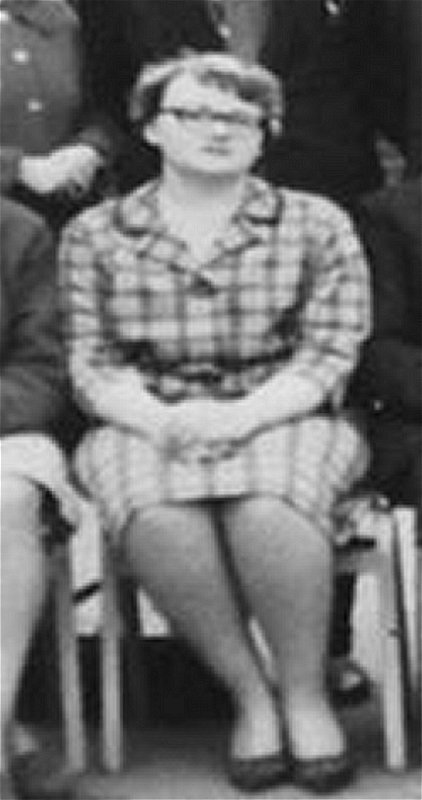
Miss Heather Shuker |
At the beginning of the autumn term in
1956 the classes were renamed. The first class
(reception) became Infants 1, and was followed by
Infants 2 and Infants 3. The Junior classes became
Junior 1 to Junior 4.
There were also a number of staff
changes. In the late 1950s there was a large turnover of
staff, which at times led to a shortage of teachers and
must have been a constant worry to Mr. Mayland. Some of
the significant changes were as follows:
1st September, 1954 Miss
Heather Shuker arrived after completing her course at
Coventry Training College. She took over class 5.
Miss Shuker stayed at the school until July 1959 when she
transferred to Kings Hill Junior School.
Another
newcomer was Mr. Victor West who took over Junior 2 in
September 1956. He had previously taught at Old Church
Junior School.
Mrs. Gwendolen Hill who had been at the
school since February 1944 retired in July 1954 and was
presented with bouquets and a cheque.
She later returned
for a while, working part time to ease the school’s
staffing shortages.
|
In February 1957 Mr. Scarth received a
well deserved promotion to Deputy Head and in November
of that year a well-remembered figure started work at
the school. He was Mr. Maybury who replaced Mr. Bartram
as school caretaker.
The number of children attending
the school was as follows:
| |
January |
September |
|
1953 |
402 |
362 |
|
1954 |
380 |
322 |
|
1955 |
331 |
300 |
|
1956 |
328
|
270 |
|
1957 |
306 |
273 |
|
1958 |
288 |
262 |
|
1959 |
296 |
237 |
The attendance figures were often poor
in the early and late part of each year, the weather
being an important factor. Winters were much colder than
today with frequent falls of snow. Heavy fog was also a
problem, which thankfully has now disappeared due to the
Clean Air Acts and the decline in industry. Today’s
better standards of living have led to an overall
improvement of health. We still get coughs, colds, and
flu, much as in the 1950s, but not so many cases of
mumps or measles thanks to the MMR vaccination (measles,
mumps, and rubella).
In January and February, 1954
attendances were very low, falling at one point to 292.
There were snow falls and outbreaks of colds, influenza,
and mumps. A year later attendance was down to 269, only
14 children were present in class 7. At the end of
January the attendance had fallen to 215 due to
influenza. In February 1957 there were 58 cases of
measles, and in February 1959 the attendance fell to 220
because of an epidemic of colds and bronchitis. In March
there were a number of cases of measles and chicken pox.
On 17th November,
1957 sixty children were absent because of thick
fog, colds and sore throats. Today it’s hard to
imagine the effects of a thick fog, which could
reduce visibility down to a couple of metres. It
was easy to get lost especially as you couldn’t
even see across the road. It could be a very
unpleasant experience battling your way to
school through a thick fog on a cold winter’s
day.
|
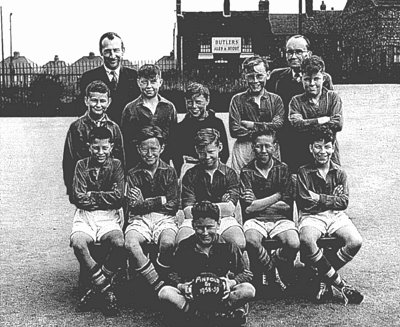
The school
football team - 1958 to 59. Courtesy
of Brian Stanley.
Names Left to Right:
At the back are Mr. West and Mr
Scarth.
Back Row:
Brian Stanley, John Fiddler,
Geoffrey Green, Roger Anderson, Alan Jones.
Front Row:
David Woodcock, Alan Humphries,
Victor Fellows, Keith Bailey, Terry Sheldon.
In front is Tony Carless. |
Throughout the 1950s the children were
still actively encouraged to save, something that has
been forgotten in our modern society. During National
Savings Week in October 1954 a ceremony was held at
Darlaston Town Hall to celebrate the savings campaign. A
number of children from the school attended the
ceremony. Mr. Mayland, like his predecessor, collected
and banked the children’s savings, which were paid out
at the end of each school year. In July 1955 the total
amount saved was £1054.16s.0d. This was quite an
achievement considering that in today’s money it is
equivalent to about £19,100.
Children also gave generously to
worthwhile causes. In 1955 after a talk to the juniors
at the school, given by Miss Kirkpatrick of the
Institute for the Blind, a collection in classes 1 to 5
raised £32 for the Midland Societies For The Blind. In
1956 £8.2s.8d. was raised for the Mayor of
Wolverhampton’s Hungarian Relief Fund, which is
equivalent to about £150 in today’s money.
|
|

A class in 1959. Courtesy of Sue
Harper,
Gill Broomhall and Maureen Page.
Names Left to Right:
Back Row: Mr. Mayland, Terry
Sheldon, Paul Hayward, Diane Edge, Pauline
Holmes, Janet Moreton, Susan Barlow, Penny
Chapman, Pamela Spencer, Janice Roberts,
Brian Hayward, Brian Stanley, Mr. Scarth.
3rd Row: Geoffrey Green, Tony Carless, Alan
Humphries, John Fiddler, Alan Jones, Keith Allen, David
Shut, Roger Anderson, Raymond Devy, Victor Fellows,
Keith Bailey, David Woodcock.
2nd Row: Patricia Priest, Carol Windows, Joan
Shenton, Gillian Foster, Joan Dwyer, Christine Lavender,
June Cox, Jane Duley, Dorothy Reed, Alma Clifford, Wendy
Harper.
Front Row: Graham Evans, Kenneth Hunt,
Lawrence Jones, David Skidmore, Neil Benton. |
|
The annual Harvest Festival in the school hall, held
in September or October also raised money for good
causes. Parents would generously donate fruit,
vegetables and other items which were
sold later in the day. In 1955 £8 was raised for the Old
People of Darlaston Fund, in 1956 Moxley Children’s
Hospital received £8.12s.6d., and in 1959 the hospital
received a grand total of £17.12s.7d.
The school was managed by the
school management group who consisted mainly of the
headmaster and several councillors, or ex-councillors.
During the second half of the 1950s there were two
chairmen, Councillor Mrs. Wilkinson who was followed by
Councillor E. Sutton. Other members included Councillor
Brown, Councillor Partridge, Mrs. Hitch, Mr. E. Owen,
Mr. Stanbury, Mr. Foster, and Mr. Bull. As well as
running the school’s day to day affairs the managers
could grant extra holidays, interview prospective
employees, and the chairman would issue a stern warning
to any parent who was found to be keeping their child
away from school without a good reason.
Throughout the late 1950s the
school managers made proposals for the building of the
school playing field and attempted to make the project a
reality. In 1955 they considered the possibility of
obtaining the land adjoining Moxley Road where most of
the old Victorian houses had just been demolished. In
February 1956 they discovered that the local authority
proposed to purchase 1 acre of land adjoining the school
for a playing field, so their labours were beginning to
bear fruit. Unfortunately such proposals often take a
long time to materialise, and little seemed to be
happening at the time.
In 1958 they examined the latest
plans for the project which now covered around 2 acres,
including the land adjoining Moxley Road. At the time 4
of the old houses were still occupied and although
demolition was planned, nothing could be done until the
occupants were re-housed. The council were asked if work
on part of the project could begin, and be completed
later when the land occupied by the houses became
available. At their last meeting in 1959, the managers
were informed that work on the project would soon begin.

| Mr.
Scarth and a group of boys,
possibly the school football
team in 1954 to 1955. Courtesy
of Sue Harper,
Gill Broomhall and Maureen Page. |
Names Left to Right:
Back Row: Roger Hurley, Colin
Gould, Alan Page, John Beech, Graham Spruce,
Barry Arblaster, Billy Holland, Leslie
Foreman, Clive Brown, Ronald Gregory,
Stephen Ratcliffe,
?
Front Row: Terry Wain, Lawrence
Ellis, John Walters, ?, David Hughes, Brian
Bayliss, Edwin Norman, Raymond Cornforth,
Bernard Tonks. |
In October 1956 the school
purchased its first tape recorder and in May of the
following year Rediffusion (an early wired radio and
television service provider) wired-up 2 infants and 2
junior classrooms, and the hall. A large loudspeaker was
also fitted in the hall.
In May 1958 Slater Street
Secondary Modern School suffered the effects of an arson
attack, which destroyed part of a building. As a result
the local police obtained a key to Pinfold Street
School’s playground so that they could carry out nightly
patrols around the school. Luckily the arsonist was soon
arrested and so the patrols were no longer necessary.
The school in the 1950s is best
summed up by the words of Miss Evans, an H.M.I.
inspector. When she visited the school to inspect the
juniors, this is what she had to say “There is a good
spirit in the school, staff and children work well, and
a very happy relationship exists.”
|
 |
|
 |
|
 |
Return to The
Post War Years |
|
Return to the
beginning |
|
Proceed to
Into The 1960s |
|